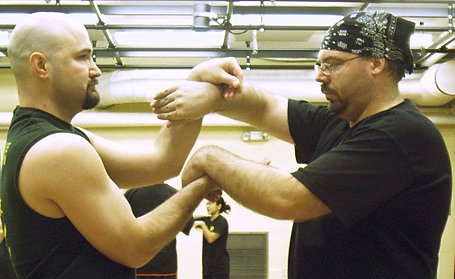
Chi sao is a sensitivity exercise done prominently in Wing Chun Kung Fu, though similar exercises are found in other Kung Fu styles. Chi sao is often misunderstood when appropriated by those of other martial art styles, however. The term means “sticky hands,” and a typical chi sao drill involves two people whose hands and arms are in contact with each other.
There are different chi sao drills. When I trained in Wing Chun Kun Fu (I’ve since earned my black belt in Liu Seong Gung Fu) I started with single hand chi sao, for example, which followed a very set pattern of movements. One student holds his hand in tan sao, the “dispersing hand.” Another holds his same-side hand and arm in fook sao, the “hooking” or “subduing” hand. The student holding a tan sao executes jing jiang, a palm strike. The student holding fook sao turns the “hooking hand” into a jut sao, the “jerking hand.” He then delivers a vertical punch and the other student uses bon sao, the “wing arm,” to stop the punch from striking him in the head. This is done repeatedly.
Simple chi sao exercise. Fook sao, jut sao, punch –
or tan sao, jing jiang, bon sao – over and over again.
As we progressed in Wing Chun, we learned to “run” — that is, to circle around tightly and strike when the other student exerted pressure that he or she should not be exerting while performing chi sao. In this way, sensitivity to the opponent’s movements — his or her “energy” directed toward you — is developed. Let me be clear that the term “energy” here does not mean “chi” or The Force or some other nonsense. I’m talking about physical movement or perhaps kinetic energy (depending on how liberal we are with our terminology).
After these initial stages I started practicing cross-arm chi sao, which starts out from a position that reminds me of the Bruce Lee and John Saxon fight scenes during the competition bouts in Enter the Dragon. The goal of each student is to deliver a light strike from that position while preventing the other student from doing the same, using a variety of hand techniques – lop sao to pull the other student’s hand out of the way while delivering a strike, for example. Cross-arm chi sao feels a lot more like actually sparring someone, whereas the simpler single-arm chi sao really bored me at first.
Cross-arm chi sao. Looks fun, doesn’t it?
While chi sao starts out very “dead” and pattern-oriented, students progress from these static stages (which allow them to develop a base on which to build – if you can’t learn to sense the physical movements of someone who is squared off to you and performing a specific pattern, you’re not going to be able to do this in a free-form environment) to a much more dynamic form of chi sao.
Among those who’ve “played” chi sao long enough, sticky hands attributes translate directly to going around and through an opponent’s guard to strike him or her. I’ve done this a talented JKD/Kali instructor, and in the words another student, “It’s like fighting a ghost.” When you try to strike such a person — this is free form, not a cross-arm or other patterned exercise — he’ll react to the contact of your arms by not being there, all while working around your guard to strike you. It’s extremely unsettling and an advanced application of touch reflexes.
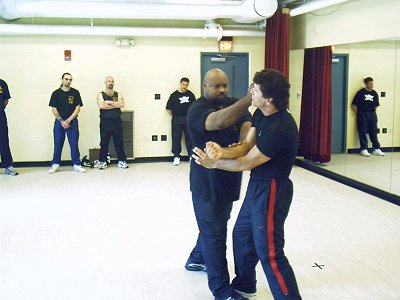
Sifu Eric Winfree (left) and Guru Kevin Seaman apply touch reflexes.
The importance of chi sao drills was first driven home to me during an exercise with my instructor involving knives. We had been discussing knife fighting, not chi sao. Using a rubber knife, I attacked him, while he sought to check my elbows to stop me and counter my attack. At one point his initial bock of my strike missed. His chi sao sensitivity training allowed him to counter immediately and stop me from “stabbing” him without conscious thought on his part. Using his body, he sensed the “energy” of my missed incoming attack and he reacted accordingly.
By this I do not mean he used some sort of ESP or mystical powers to react to my attack like some mythical blind swordsman. I mean that he reacted instinctively, using the reflexes developed in training touch sensitivity, to the mechanical force of my attack and the feeling of his missed block. You’d never be able to do this fast enough if you were consciously thinking about it. That’s the “mind of no mind,” as they say in Asian martial arts.
Instructor (left) demonstrates with student (right)…
…to show the benefits of sensitivity when “touching hands.”
Those who do not grasp the point of chi sao or who fail to understand the benefits of the attributes it develops in the long term often pan the “playing” of sticky hands as a waste of time. “Why spend hours doing sticky hands when a chin jab or an axe hand is so much easier to learn?” they ask. “You don’t need this traditionalist nonsense to learn to fight.” Well, no — you don’t need to learn chi sao to be able to deliver force to someone. You don’t need to be able to draw to sketch a map for someone, either, but it’s always nice to have talents beyond the very rudiments of a skill.
Other critics argue that there are better ways to develop touch sensitivity than chi sao, “trapping,” or hubud practice. There are different ways, to be sure, but I would hesitate to call one better than the other provided they perform the same long-term function. I thik some people also tend to try to “run before they can walk,” skipping the often dull development of basic skills to go directly to more interesting touch-sensitivity applications. If you do this, you’re only shortchanging yourself. To dismiss as “useless” the methodology you do not use is simply ignorant if you agree that the goal is worthwhile – but this no worse than pursuing that goal while ignoring the foundation you need to achieve it.
Chi sao‘s benefits are felt over time. It helps produce more efficient, more effective fighters who act by reflex and who possess enhanced awareness of an opponent’s actions. This awareness is not magical — it is a physical skill like any other. When you’ve fought someone who’s spent time developing this, you’ll understand why it’s a good thing.
Chi sao, to be done properly, must be understood properly. To develop it, seek instruction from a qualified teacher.
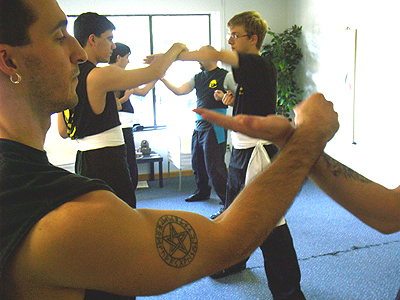
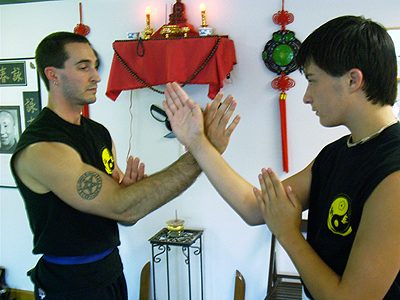
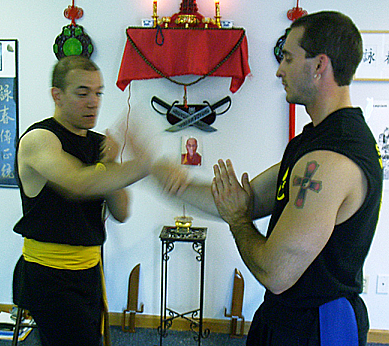
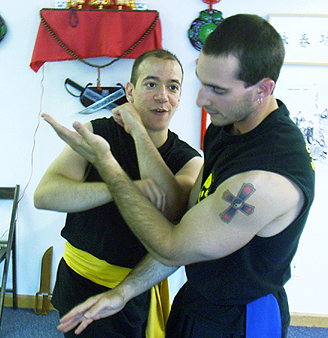
This is a great article on Chi Sao. I found in my studies that chi sao really does help bridge the gap between knowing and not knowing.
The practice of sticky hands can help anyone in any martial arts.
Once a person develops a high level of stick hands, it becomes easier to fit in with other fighting styles.